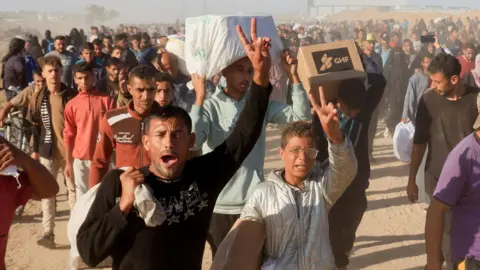More than 130 charities and non-governmental organizations (NGOs) have called for the disbanding of the Gaza Humanitarian Foundation (GHF), which has been established with the backing of the United States and Israel. This public outcry stems from the alarming reports of over 500 casualties among Palestinians who were seeking aid since the foundation commenced its operations in late May, following Israel’s extensive three-month blockade on Gaza. The agencies involved in this condemnation include notable organizations such as Oxfam, Save the Children, and Amnesty International, as well as at least nine organizations with headquarters based in Israel.
The recent surge in violence against Palestinians seeking essential assistance has raised serious concerns. According to these organizations, Israeli forces and armed factions have consistently opened fire upon individuals attempting to receive aid, highlighting a grim situation on the ground where humanitarian support has become life-threatening. Despite these grave accusations, Israel has rejected claims that its soldiers intentionally targeted aid recipients, insisting that directives had been distributed to military personnel following critical evaluations and “lessons learned” from ongoing conflicts.
Adding to the gravity of the situation, a report from an Israeli newspaper suggested that there may have been official orders permitting the use of live ammunition against civilians—further complicating the narrative surrounding the GHF’s operations in Gaza. In ongoing reports from aid distribution sites, the United Nations has highlighted that the broader population is at risk of starvation, with Israel frequently obstructing the entry of humanitarian supplies into Gaza.
The joint statement released by several leading charity organizations in response to the GHF’s actions articulated a clear position: the foundation should halt its activities immediately and be supplanted by a United Nations-led humanitarian system. The statement condemned the GHF for breaching essential principles of humanitarian work, such as forcing a population of two million people into densely populated and militarized zones where they endure daily gunfire.
Eyewitness testimonies from medics, civilian witnesses, and the health ministry controlled by Hamas indicated that since the GHF became operational in Gaza, there have been ongoing reports of fatalities among those seeking aid. The new aid distribution approach has dramatically reduced the number of operational centers from 400 during a temporary ceasefire between Israel and Hamas to only four military-controlled distribution sites. These centers are located in the far southwest and central parts of Gaza, further emphasizing the logistical challenges faced by those in desperate need.
As per the recent statement from the NGOs, Gazans now confront an impossible dilemma: to either starve or risk being shot while desperately searching for food to sustain their families. The tragic implications of the aid strategy have led to the deaths of orphaned children and caregivers, reflecting the dire humanitarian crisis currently characterizing the region. Notably, children have been victims in over half of the documented attacks on civilians at these distribution sites.
Internationally, the GHF aid distribution methods have garnered criticism from various UN agencies. UN Secretary-General Antonio Guterres openly denounced the setup, describing it as “inherently unsafe.” From the outset, the UN had opposed plans that purportedly militarize humanitarian assistance and undermine existing distribution networks, compelling residents of Gaza to navigate perilous paths to secure food supplies.
Although the Israeli military has indicated it will investigate civilian harms reported in connection to GHF distribution centers, it maintains that any use of force against civilians was not intentional. Additional concerns arose from allegations reported in the Israeli newspaper Haaretz, which quoted unnamed Israeli Defense Forces (IDF) members claiming orders to engage unarmed civilians seeking aid were in place to deter crowds.
In light of severe hunger and conditions reminiscent of famine, many families have expressed that they are now too weak to compete for food rations. The implications of this humanitarian crisis affirm the statement made by the aid organizations—that the current response is far from being a viable humanitarian strategy, reflecting a significant failure in delivering much-needed assistance.











